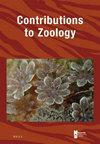副甲藻科Iberbathynellini部落的分裂分布、生物地理学、形态和遗传多样性
IF 2.2
2区 生物学
Q1 ZOOLOGY
引用次数: 4
摘要
“Iberobathynella群”,或Iberobathynellini部落,是一个由6个属组成的综合体,包括33个名义种和几个隐种,分布在两大西洋(欧洲、北非和北美)。这里提出了这组地下甲壳类动物的现代系统修订。利用形态学和分子数据(线粒体coi和核18S)进行系统发育和生物地理研究,A)重新评估先前建立的亚部落、属和亚属在数据中显示一致性的分类地位和有效性;B)评估鉴定的线粒体谱系是否代表隐种;c)为Iberobathynellini内部的关系以及与栖息在北美和欧洲的parabathynellae科的另外两个属(分别为Montanabathynella和Parabathynella)的关系提供一个合理的系统发育假说;d)基于形态类型的当前分布及其估计的分化时间,为伊比利亚obathynellini部落的多样化和进化提出一个合理的时间和历史框架(古生物地理情景)。我们的结果表明,在副颌属中,分子和形态的差异并不总是一致的。亚族和亚属是无效的分类,所以它们必须被淘汰。副叶蕨属需要重新考察。分子定年结果支持Iberobathynellini部落(上白垩纪,约78 Mya)的早期分化和板块构造的差异是解释这一古代地下甲壳类动物群跨大西洋分布的主要因素。由于存在形态上与大鼠和免疫鼠非常相似,但遗传上不同的物种,我们可以确定至少存在三个隐种。Texanobathynella无疑是一个与Iberobathynella不同的有效属。Montanabathynella和Parabathynella是与Iberobathynellini部落密切相关的两个分化良好的属。本文章由计算机程序翻译,如有差异,请以英文原文为准。
Split distribution, biogeography and morphological and genetic diversity of the Iberobathynellini Tribe in the family Parabathynellidae (Crustacea, Malacostraca, Bathynellacea)
The “Iberobathynella group”, or Iberobathynellini tribe, is a complex of six genera consisting of 33 nominal species and several cryptic species with an amphiatlantic distribution (in Europe, North Africa and North America). A modern systematic revision of this group of subterranean crustaceans is presented here. A phylogenetic and biogeographic study using morphological and molecular data (mitocondrial coi and nuclear 18S) was carried out and allowed to a) re-evaluate the taxonomic status and validity of previously erected subtribes, genera and subgenera that show congruence in the data; b) assess whether the identified mitochondrial lineages represent cryptic species; c) provide a plausible phylogenetic hypothesis for the relationships within Iberobathynellini and with the other two genera of the family Parabathynellidae that inhabit North America and Europe (Montanabathynella and Parabathynella, respectively); d) propose a plausible temporal and historical framework (paleobiogeographic scenario) for the diversification and evolution of the Iberobathynellini tribe based on the current distribution of morphotypes and their estimated times of divergence. Our results show that in parabathynellids, molecular and morphological divergences are not always congruent. Subtribe and subgenus are invalid categories so they must be eliminated. Paraiberobathynella genus needs to be revisited. The molecular dating results support the early divergence of the Iberobathynellini Tribe (Upper Cretaceous, around 78 Mya) and the vicariance by plate tectonics as main factor to explain the amphi-Atlantic distribution shown by this ancient subterranean crustacean group. Since there are species morphologically very similar to I. magna and I. imuniensis, but genetically different, we can ensure the existence of at least three cryptic species. Texanobathynella is undoubtedly a valid genus distinct from Iberobathynella. Montanabathynella and Parabathynella are two well-differentiated genera closely related to the Iberobathynellini tribe.
求助全文
通过发布文献求助,成功后即可免费获取论文全文。
去求助
来源期刊

Contributions to Zoology
生物-动物学
CiteScore
4.00
自引率
4.50%
发文量
16
审稿时长
>12 weeks
期刊介绍:
Contributions to Zoology solicits high-quality papers in all systematics-related branches of comparative zoology (including paleozoology). Preference will be given to manuscripts dealing with conceptual issues and to integrative papers (e.g., ecology and biodiversity, morphology and phylogeny and character state evolution, phylogeny and historical biogeography, systematics and bioinformatics, bioinformatics and biodiversity, habitat disturbance and biogeography, etc.). Reviews and alpha-taxonomic contributions are considered for publication, but acceptance will depend on their high quality and exceptional nature.
 求助内容:
求助内容: 应助结果提醒方式:
应助结果提醒方式:


